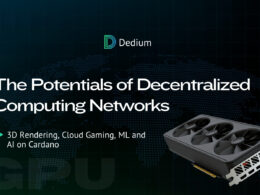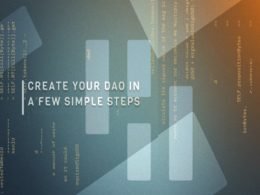Congratulations on getting yourself some Cardano (ADA)! So you’ve got your ADA in a wallet and you’re now probably wondering what to do next. Whether it’s staking, checking out decentralized applications (dApps) or simply sitting on your ADA for future price gains, we’ll explore the different options available to you, and show you what to do next.
Cardano is a blockchain of the third generation Blockchain innovation, and is designed to address the limitations experienced by the current blockchains such as Bitcoin and Ethereum. These limitations include scalability and energy consumption. ADA is the native cryptocurrency that powers the Cardano blockchain and it is used to run a PoS (Proof-of-Stake) consensus mechanism Ouroboros that is more energy efficient and scalable than PoW (Proof-of-Work) system, like Bitcoin.
Cardano, unlike most other blockchains, divides its utility into two layers: the Cardano Settlement Layer (CSL), for handling transactions, and the Cardano Computation Layer (CCL), which is used to run smart contracts — this means Cardano can handle transactions more quickly and efficiently than older blockchains.

Store Your ADA Securely
Before we begin observing any ADA use-cases, please ensure your tokens are stored in a wallet (preferably a secure one!). Cardano has two main wallets available – Daedalus and Yoroi.
- Daedalus is a full-node wallet which implies that it downloads the entire blockchain and therefore is more secure compared to other wallets but requires more resources.
- Yoroi is a light wallet which is more friendly for new comers and does not require the long process of downloading the full blockchain.
Alternatively, you could use cold storage wallets such as Ledger or Trezor for optimum security. Storing your ADA in a cold storage wallet dramatically reduces the risk of online thefts.
Start Staking Your ADA
One of the easiest ways to spend your ADA is through staking. By doing this, you can earn a passive income while helping to secure the network. You don’t even have to run a node yourself; instead, you just delegate your ADA to a pool of validators who will do that for you and in return, you will get a share of the network’s transaction fees.
The annual return for staking ADA fluctuates but is usually around 4-5% in total. Your ADA remains in your control and you can withdraw it at any time. Whether you stake using one of the Cardano network wallets Daedalus or Yoroi, or through an exchange such as Binance or Kraken, this is the best way to gain more ADA over time.

Explore Decentralized Applications (dApps)
Cardano recently rolled out smart contract capability which means developers can now create dApps (Decentralized Applications) on its blockchain. If you are interested in DeFi (Decentralized Finance) then Cardano has a growing ecosystem of platforms where you can lend, borrow and trade assets on. Cardano’s dApp ecosystem is still in its nascent stage but it is definitely an area that is starting to get blockchain developers and users excited.
You can explore dApps on Cardano to:
– Trade assets on decentralized exchanges (DEXs)
Lend your crypto and earn interest
– Interact with NFTs (Non-Fungible Tokens)
As more dApps launch, we expect Cardano to compete with other smart contract platforms such as Ethereum and Solana.
ADA as a Medium of Exchange
ADA can also be spent or transferred. There are a number of growing platforms that accept ADA as a form of payment in exchange for goods and services, for example you can:
– Make peer-to-peer payments using ADA
ADA is accepted by more than 40,000 merchants worldwide. You can buy gift cards for major retailers including Amazon, Walmart, and Nike with ADA via services like BitPay.
– Purchase goods and services on the Internet (where such offers exist).
While ADA is primarily considered as an investment and staking choices but with growing usage of cryptocurrencies as means of payment, brings opportunity to use ADA for day to day transactions.

Participate in Governance and the Future of Cardano
Cardano’s final development phase, Voltaire, will develop a Decentralized Governance system for Cardano. This means that ADA token holders will be able to submit proposals and vote on possible Cardano network improvements. You’ll be able to participate in submitting and voting on improvement proposals too. By delegating your ADA stake and participating in the network’s governance, you’ll have the power to influence what happens going forward. You can help decide which upgrades are implemented next, what new functionality gets added, or how funds from the Cardano Treasury get spent in developing the platform.
Stay Informed on Upcoming Developments
Cardano is a work in progress and knowing what’s coming down the pipeline can help you to maximize your investment opportunities. Cardano is working on a scaling solution called Hydra which could potentially make the network capable of processing millions of transactions per second. Cardano is also making a big play for partnerships in new markets, partnering with governments and enterprises to use blockchain for real world use cases such as identity management and supply chain tracking.
Use ADA for Yield Farming and Liquidity Pools
Apart from staking, ADA tokens can be used in yield farming and liquidity pools on decentralized finance (DeFi) platforms. Yield farming is the practice of locking up your ADA tokens (and possibly other tokens) in a DeFi protocol to earn additional cryptocurrency rewards. By providing liquidity to decentralized exchanges or lending platforms, you can earn fees or interest while also helping to facilitate cryptocurrency trading or lending. This potentially provides higher returns than staking but carries additional risks such as impermanent loss or protocol exploits.

Long-Term Holding and Price Speculation
Many investors choose to hold ADA for the long term, believing in the project’s future growth. Cardano’s capped supply of 45 billion ADA coins ensures a degree of scarcity, which could drive up value over time as demand increases. Long-term holders may also benefit from future technological upgrades and growing adoption of Cardano in real-world applications.
As with any cryptocurrency investment, it’s essential to monitor market conditions and stay informed about major developments, both within the Cardano ecosystem and in the broader cryptocurrency market. Prices can be volatile, so having a strategy (such as dollar-cost averaging) may help reduce the risks associated with sudden market fluctuations.
Also, If you’re serious about Cardano and ADA, consider joining the active Cardano community. The Cardano Foundation, IOHK, and Emurgo are the three organizations behind Cardano, and they frequently release educational resources and news about the platform. Joining forums like the Cardano subreddit or Telegram groups can help you stay updated and connect with other ADA holders.
Moreover, Cardano is an open-source project, meaning that anyone can contribute to its development. If you have technical skills or simply want to support the ecosystem, you can participate in various development or outreach initiatives.
Conclusion
Now that you have ADA, the possibilities are diverse. Whether you choose to stake your ADA for passive income, explore the DeFi ecosystem, or hold onto it for the long term, understanding how Cardano works and staying involved in its community can help you make the most out of your investment. With its focus on sustainability, scalability, and real-world applications, Cardano offers a promising future for those willing to dive into its ecosystem.
About The Author
Hello guys! I Blockchain Mouthpiece, an experienced cryptocurrency writer who has been in the game since 2018, crafting the best articles which are proven to be both insightful and engaging to the satisfaction of users. My aim is to bring the complexities of cryptocurrency, Blockchain technology, and Web 3, to the barest minimum, to make adoption more seamless and fast among both seasoned and new users alike.










